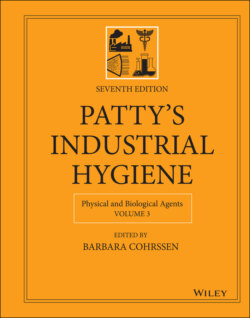Читать книгу Patty's Industrial Hygiene, Physical and Biological Agents - Группа авторов - Страница 113
4.1.2.1 Blue‐Light Hazard
ОглавлениеHigh retinal irradiances from short‐wavelength optical radiation may cause photochemical damage to the retina, leading to loss of visual acuity. This hazard is referred to as the “blue‐light” hazard because the effect is greatest in the blue region of the optical spectrum between 435 and 440 nm.
The ACGIH TLV for protection against the blue‐light hazard (20) is similar, but not identical, to the ICNIRP exposure limits (19). The source spectral radiance Lλ is weighted by a blue‐light hazard function B(λ) over the range 305–700 nm:
(13)
for exposure time t less than 10 000 seconds, or
(14)
for time greater than 10 000 seconds. The blue‐light hazard function B(λ) is plotted in Figure 9. The ICNIRP blue‐light hazard weighting differs from the ACGIH function by including 300–305 nm radiation with a weighting factor of 0.01. For light sources that subtend an angle less than 11 milliradians (mrad) at the viewer's eye, the TLV is determined from the blue‐light‐hazard‐weighted irradiance incident at the eye. The blue‐light‐hazard‐weighted irradiance multiplied by the exposure time should not exceed 0.01 J cm−2 for exposure time less than 100 seconds. For exposure time greater than 100 seconds, the blue‐light‐weighted irradiance should not exceed 0.1 mW cm−2.
